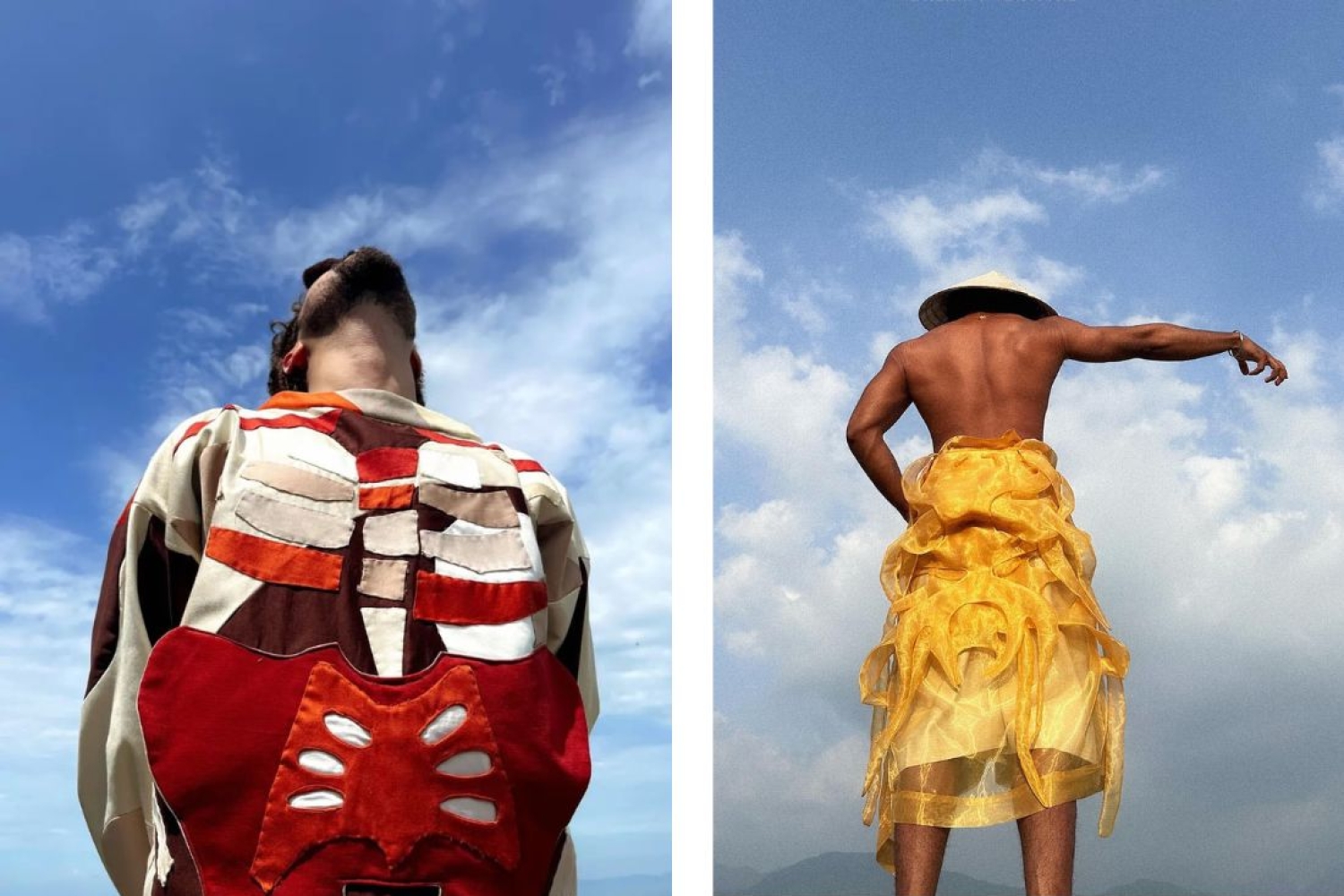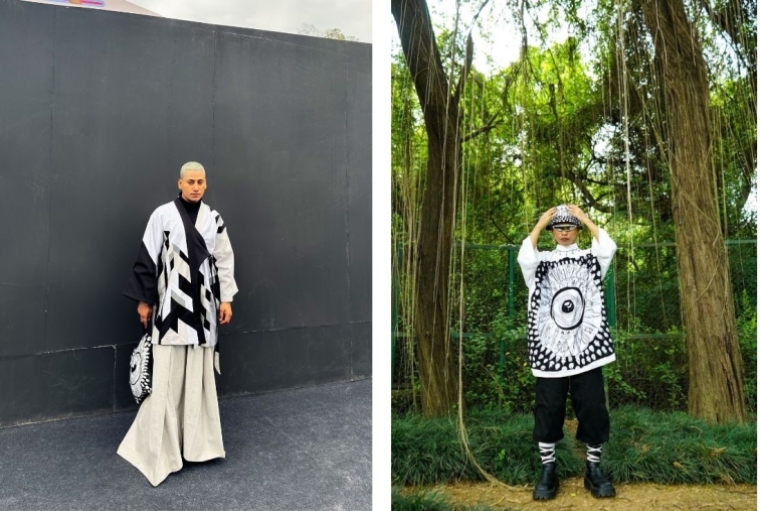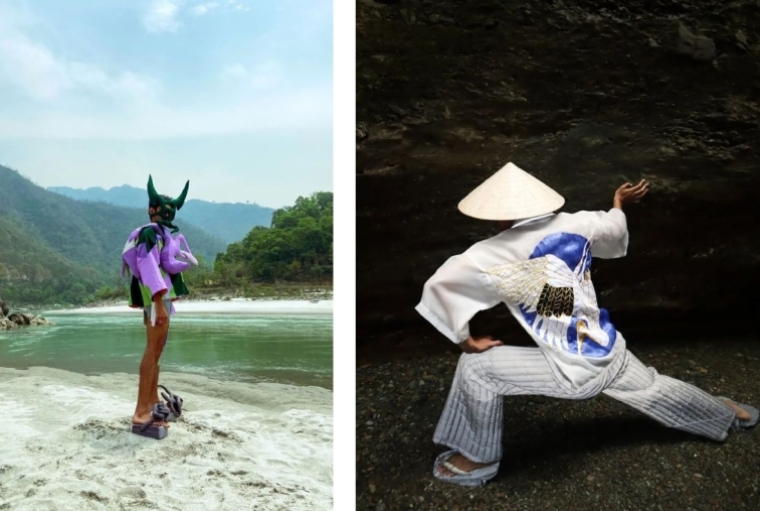

Based in Dehradun, Walking Vertical seamlessly merges the avant-garde aesthetics of Tokyo streetwear with intricate textile techniques to re-imagine existence through design. This innovative approach combines the utility and wearability of fashion with surreal, expressive forms. Japanese streetwear, known for its sustainable pattern making— where fabric waste is minimized—inspires their design. By adopting similar sustainable practices, the brand creates versatile pieces that fit various shapes and sizes, reflecting a deep commitment to both form and function. Founder Akash Patwal lets us into the brand’s approach to clothing, their goals, and creative process.

Akash Patwal (lef)
BLENDING TOKYO STREETWEAR WITH TEXTILE ART
Patwal describes his approach as one that ‘takes you to a space where existence is re-imagined with the expression of a surreal mind, making forms not only to be desired but also following the function of utility and wearability.’ Walking Vertical represents a unique self-expression where ‘symbolism, culture, and fashion are seamlessly integrated into the fabric.’ The influence of Japanese streetwear, particularly its sustainable pattern-making practices, plays a significant role in this creative process. Patwal notes that Japanese streetwear’s approach—where patterns are cut in a manner that leaves no fabric waste—inspires the brand’s commitment to creating Haoris that are versatile and sustainably designed, fitting various shapes and sizes.
THE ROLE OF TEXTILE TECHNIQUES IN THE CREATIVE PROCESS
In today’s fashion landscape, there is a growing empha- sis on slow and sustainable fashion, with designers and artists gaining recognition for their unique voices andexpressions. Patwal sees Walking Vertical as part of this movement, aiming to ‘re-establish the long lost contact between art and public, between living people and art as living things.’ He envisions his work as not just wearable clothing but also as artwork that can be appreciated on the wall. This philosophy aligns with the current trend towards fashion that offers ‘creative integrity, authenticity, and a sentimental personalized feel,’ positioning Walking Vertical as a brand that stands out in a fast-paced, trend-driven industry.
Patwal’s work is rooted in tactile exploration and intuitive design. ‘I am more inclined towards tactile surfaces,’ he explains, ‘and my mind likes to connect dots, which leads to trusting my subconscious mind while I layer different textile surfaces together to create unique visual and tactile work.’ His creative process is influenced bypersonal and environmental experiences, with ‘the visual sensation of my daily chaos’ adding texture and depth to his pieces. Techniques like embroidery, eco-printing, and patchwork are chosen based on their ability to contribute to this tactile and visual richness, allowing Patwal to create textiles that are both visually stunning and meaningful.
INFLUENCE OF LOCAL ENVIRONMENT AND CULTURE
Operating from Dehradun, Patwal finds his local environment and cultural heritage to be crucial influences on his designs. ‘Dehradun’s slower pace allows for a thoughtful, almost meditative approach to design,’ he says, contrasting with the rapid, trend-driven nature of global streetwear. This local perspective grounds his work in ‘nature’s vibrancy and the region’s rich cultural heritage,’ creating pieces that are globally relevant yet deeply rooted in the mindful and artistic ethos of the local culture.
Patwal also notes ‘The availability of local textile artisans in Dehradun has been one major hurdle.’ To overcome this, Walking Vertical has focused on training local women and tailors, introducing them to new techniques and possibilities. This approach ensures a balance of ‘innovation and functionality,’ allowing the brand to produce textiles that are both unique and practical.
FUTURE DIRECTIONS
Looking ahead, Patwal is excited about exploring new techniques and concepts. ‘We at Walking Vertical still have a lot to learn by traveling to new places and picking up unique textiles,’ he shares. The goal is to ‘materialize new futures and directions by giving the usual a very unusual approach,’ continuing to innovate while preserving the essence of past techniques. This forward-thinking approach will allow Walking Vertical to evolve and remain at the forefront of both fashion and artistic practice.
Words Paridhi Badgotri
Date 08.09.2024
